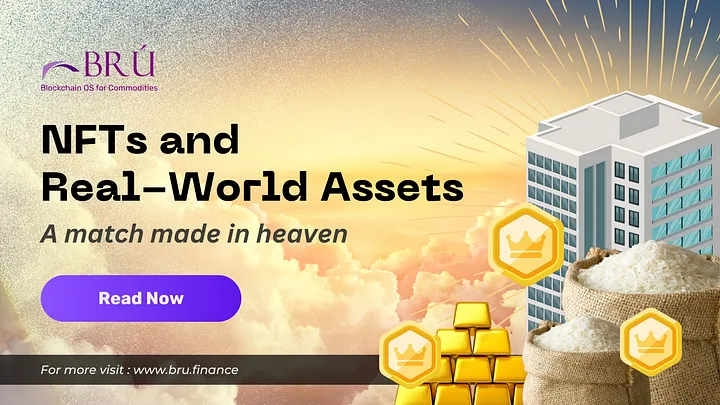
NFTs and Real-World Assets: A match made in heaven
Published On : March 15, 2024
Non-fungible tokens (NFTs) are digital certificates of ownership stored on a blockchain, a decentralized network of computers that records and verifies transactions. NFTs can represent any unique asset, such as digital art, music, videos, games, or physical objects. Unlike traditional digital files, which can be easily copied and distributed, NFTs are scarce and indivisible, meaning there can only be one owner of each NFT at a time.
NFTs have gained popularity in recent years, especially in the creative industries, where artists and collectors have embraced them as a new way of creating and exchanging value. NFTs allow artists to monetize their work directly, without intermediaries or gatekeepers, and to retain control over their intellectual property. Collectors, on the other hand, can enjoy the benefits of owning rare and authentic digital assets, as well as supporting their favorite creators.
However, NFTs are not limited to the digital realm. They can also represent real-world assets, such as physical goods, certificates, tickets, or memberships. NFTs can enable the digitization and tokenization of these assets, making them more accessible and transferable online. For example, an NFT can be linked to a piece of art, a car, a house, or a diamond, and the ownership of the NFT can be transferred along with the ownership of the physical asset. Alternatively, an NFT can be used to prove the authenticity and provenance of a physical asset by tracing its history and origin on the blockchain.
In contrast to traditional cryptocurrencies like Bitcoin, NFTs are distinctive and irreplaceable. This attribute makes them well-suited for representing real-world assets such as art, real estate, and collectibles. Utilizing NFTs to depict physical assets offers several advantages.
Firstly, NFTs can enhance the liquidity of such assets. Tokenizing real estate, for instance, simplifies its buying and selling on secondary markets, overcoming the challenges of illiquidity associated with large assets.
Secondly, NFTs contribute to heightened security for real-world assets. Ownership of an NFT is meticulously recorded on an immutable blockchain ledger, minimizing the risk of counterfeiting or theft.
Thirdly, NFTs enhance the traceability of physical assets. The transparent blockchain ledger effectively tracks an NFT's ownership history, bolstering authenticity and provenance.
Consequently, NFTs stand poised to revolutionize the realm of real-world asset ownership and management. In the future, utilizing NFTs could span a wide spectrum of assets, encompassing art, collectibles, real estate, and even securities.
Presently, NFTs are finding practical applications in representing real-world assets:
1. Real Estate: Numerous enterprises are tokenizing real estate into NFTs, enabling fractional ownership and facilitating trade on secondary markets, thus enhancing affordability and liquidity.
2. Art: Artists sell their work as NFTs, granting buyers digital ownership of the artwork. Some artists are leveraging NFTs to create “smart contracts,” ensuring they receive royalties upon each resale of their work.
3. Collectibles: NFTs are increasingly employed to represent collectibles like trading cards, sports memorabilia, and virtual pets. This enhances the secure and transparent ownership and trade of such items.
Furthermore, NFTs hold promise in representing commodities, including agricultural products. Their uniqueness and irreplaceability make them ideal for tracing ownership and provenance of physical assets like agri commodities.
NFTs can be harnessed to:
Establish a digital ownership ledger: NFTs offer a secure and transparent record of agri commodity ownership, which is crucial for monitoring supply chain movement and preventing counterfeiting.
Serve as loan collateral: NFTs can function as collateral, granting farmers access to capital, which is particularly beneficial for those lacking conventional financing avenues.
Enable fractional ownership: NFTs facilitate the division of agri-commodity ownership, increasing investor accessibility and improving market liquidity.
Create agri commodity marketplaces: NFTs can establish efficient platforms for buyers and sellers, enhancing market efficacy and reducing costs.
While nascent, utilizing NFTs to represent agri commodities holds the potential to transform the industry. By furnishing a secure, transparent, and efficient mechanism for ownership tracking, NFTs can amplify agri commodity market efficiency and accessibility for farmers and investors.
A case in point is Brú Finance, a DeFi protocol that employs NFTs to tokenize agri commodities. Farmers deposit commodities in custodian warehouses, generating NFTs representing commodities. These NFTs then serve as collateral for loans, empowering farmers to access capital without relinquishing their assets.
As technology advances, the concept of ownership undergoes a paradigm shift. NFTs have emerged as a key player in this transformation, offering a glimpse into the future of digital ownership. The confluence of NFTs and real-world assets possesses the power to reshape industries, redefine investment strategies, and challenge established notions of value.
Imagine a world where individuals can possess a fragment of historical landmarks, esteemed artwork, or vintage cars, all through blockchain-based NFT representation. This paradigm shift could democratize ownership, enabling enthusiasts and investors to engage in previously exclusive markets. However, striking a balance between tangible and intangible aspects of these assets will be pivotal in ensuring that benefits triumph over challenges.
As NFTs continue to evolve and expand, they will likely redefine how we buy, sell, and create value in the digital and physical worlds. NFTs will not only change the nature and meaning of ownership but also the relationship between creators and consumers and between humans and machines. They will challenge us to rethink our assumptions and expectations about what constitutes an asset and how we can express our identity and creativity through it.
For more updates and latest news about Brú Finance, please join our Twitter Channel, Discord server, LinkedIn, Telegram at
Please join our Discord events and Twitter AMAs to connect directly with our founders and ask your queries.
Discord: https://discord.gg/8C9SZXDy2r
Telegram Channel : https://t.me/bruofficial
Twitter : https://twitter.com/bru_finance
LinkedIn : https://www.linkedin.com/company/bru-finance/
Facebook :https://www.facebook.com/brufinance/
Instagram :https://www.instagram.com/brufinance/?igshid=YmMyMTA2M2Y%3D

On-chain Protocol for Assets Tokenisation & Finance
 1.png)